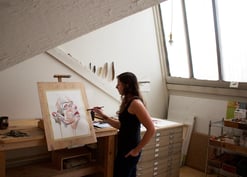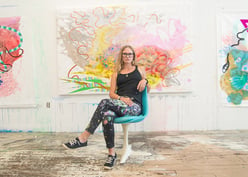Tommy Moss’s work investigates the energetic potential of color, form, and texture through dynamic, large-scale wall sculptures. Moss demonstrates a deep engagement with dimensionality, using meticulously painted surfaces to create experiential art that invites viewers to consider multiple perspectives. His joyful compositions not only encourage contemplation but also reflect his vibrant, playful aesthetic.
Moss' professional journey, marked by resilience and a distinct entrepreneurial spirit, is ultimately fueled by a passion for creativity. Through his thoughtful approach to creation and commitment to pursuing his goals, he creates work that brings a powerful sense of energy and vibrancy to public and private spaces.
Tell us about your journey to becoming a professional artist.
In the 90s, I was a devout yogi, and I founded Atlanta’s first Power Yoga studio. In early 2001, I sustained an injury that derailed my yoga career. I needed a new outlet to channel my energy, and so I started creating artwork and became a self-represented artist. Thanks to the support of art and design professionals I’ve connected with, my art is now included in hundreds of private and public collections globally.
Through this, I learned how important it is to follow what makes you happy. I believe strongly in the Law of Attraction. Miracles are all around, and they’ll find you if you remain open to them, but you still must chase inspiration, work hard, and be grateful.
Tell us about your work. What themes or messages do you hope to convey through your art?
My work fuses painting and sculpture. I create large-scale assemblages of highly colorful, textural, hand-painted modules, including wooden circles, cubes, spheres, and panels. These components are typically painted on all visible sides, giving the wall-hung sculptures a three-dimensional quality and allowing the viewer to experience the work differently from every vantage point.
I often describe my work as “minimalist forms with maximalist surfaces.” Ultimately, with all of my work, I strive to achieve a sense of playfulness through highly chromatic, contrasting color combinations and whimsical, lively compositions.
Tell us about your process. Do you have any unique techniques or rituals that are integral to your work?
My process involves extensive digital design, revision, and experimentation with geometric shapes and contrasting color palettes. While the final work hopefully appears dynamic and spontaneous, that sense of effortless energy is actually the product of meticulous, detailed planning and time.
What is your advice for combating creative blocks? Are there any specific strategies you use to reignite your creativity?
Honestly, creative blocks are less of a problem than finding time to create all the new ideas I have. I am very fortunate to have a steady stream of work, so it can be a challenge to balance paid commissions with personal projects that explore new designs and concepts. That being said, keeping my studio clean and organized helps encourage my creative energy and frees me to focus without distraction.
Do you consider yourself, and all artists, to be entrepreneurs? Why or why not?
Absolutely. To survive as a working artist, you have to treat your career as a business and your art as a unique product. That involves not only identifying your target audience but also creating, building, and marketing your distinctive brand, ensuring it’s recognizable and relevant in a crowded field. This requires resourcefulness, risk-taking, and relentless hard work: not only your creative skills but also a lot of marketing and business expertise.
As an artist, how do you measure your success? Can you recall a specific event or milestone in your career that made you feel successful?
Success as an artist seems to be somewhat of an anomaly to those who do not understand. People often seem confused when I tell them I am an artist for a living. I’ll hear, “That’s nice…what is your real job?”
Ultimately, my success is measured by my ability to sell what I create, which is why entrepreneurial skills are essential in this field. My art is my passion and my life, but I still need to keep the lights on! From this perspective, I would say the “milestone” in my art career was when I was able to quit my “real” job and become a full-time artist.![]()
What advice do you have for artists who are beginning to build their careers? Have there been any habits or strategies that you have adopted that you feel have created more opportunities or visibility for your work?
Working as an artist requires significant passion, risk, and perseverance, as well as the ability to approach each setback as an opportunity for a comeback.
Additionally, it’s essential to have strong sales and marketing skills to thrive in a competitive world full of creative talent. I was in sales and marketing for 20 years before I started making art, so I am not afraid to be shamelessly self-promoting. You must believe in yourself, take pride in your work, have a thick skin, and maintain the hunger to create. I work seven days a week, but it feels like play most of the time. As Warhol allegedly said, “Don’t think about making art, just get it done. Let everyone else decide if it’s good or bad, whether they love it or hate it. While they are deciding, make even more art.”
What sparked your interest in partnering with Turningart?
I had previously worked with Distinctive Art Source, and I discovered TurningArt when they acquired DAS! I have been fortunate to participate in their projects and look forward to contributing to more!
What does having your artwork in public spaces mean to you? How does it feel to see your art in environments where people can engage with it daily?
My self-proclaimed purpose is to create beautiful objects to uplift and inspire. Having my artwork in public spaces is the ultimate fulfilment of that mission. I am beyond honored and proud to have my artwork on display, where it can make daily environments feel more vibrant, dynamic, and inviting. .jpg?width=750&height=848&name=TMoss_Matrix%20Tiered%20III%20(1).jpg)
Have other artists inspired your path? If so, can you share how they have influenced your work or career?
I am an avid art history student and am deeply inspired by many of the greats who came before me:
- The monumental scale and expansive use of color echo the aesthetic of various abstract expressionists.
- My emphasis on geometric abstraction is characteristic of many Op Art painters.
- I aim for the same "visual impact" achieved by the bold and bright 1960s Pop Art creations.
How does being an artist affect your perception of the world? Do you see things differently compared ot others who might not have an artistic background?
I believe I am inherently more sensitive to my environment. As an artist, I am constantly inspired by my everyday experiences, and I tend to notice the small details that others might overlook, such as specific patterns, unique textures, and subtle color combinations.
Was there ever a moment of clarity about being an artist? Can you share an anecdote relating to your journey or realization of being an artist?
My “moment of clarity” isn’t a single event but rather a perpetual recognition. Over time, I’ve realized that making art is my “flow state,” where I am completely absorbed in and energized by the creative process, often losing all track of time. It is truly my happy place!

To see more featured TurningArtists, return to our blog. To get Tommy Moss' art in your space, set up a free consultation with an Art Advisor here!




_VSCO.jpg?width=332&height=177&name=TMoss_Continuum%20Sliver%20copy%20(1)_VSCO.jpg)

